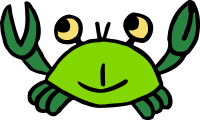Section 3 - Hello World!
1A.3.1 The Joy of Programming
You have your Visual C++, Xcode or Eclipse Integrated Development Environment(IDE) installed, and you are ready to go. Now what?
 Now it's time to have some fun.
Now it's time to have some fun.
This week we'll write a very simple C++ program just to get things moving.
1A.3.2 Hello Foothill
Here is the program that you need to think about. We'll call it the Hello World! program:
#include <iostream>
using namespace std;
int main()
{
cout << "Hello World\n";
return 0;
}
In other words, you really don't have to write a program this week because I have written it for you. (However, you'll add a few more of those cout << lines in your assignment, as you'll see.) When we get to Module 1B you'll need to copy and paste the above code into your C++ IDE and get it to run. But before doing that we will spend today's module, Module 1A, talking only about the concepts.
Other than downloading the Visual C++ or Xcode or Eclipse compiler, which you have already done, you will not actually use it to run a program until Module 1B, where I show you exactly how it's done.
I will talk about the Hello World! program, explain what it means and what it does in Module 1A, then I'll help you compile, run and capture the output in Module 1B so you can submit it to me in your first assignment.
1A.3.3 The C++ Language and C++ IDEs
The C++ language is platform independent, which means a program like the one above should run on any computer (platform). However, getting it to run means typing it (or pasting it) into a C++ IDE like VC++, Xcode or Eclipse, and using the controls of that IDE to modify, compile, debug and run it. These IDEs all work differently.
As you know, the IDEs we are using in this class are Visual Studio 2012/13, Xcode or Eclipse. There are other IDEs, but if you use those you'll have to get support for those other IDEs from the supplier.
NEXT:
- We Study the source code for Hello World!, the little 7-line program written above.
- We Discuss the meaning of compiling, running, capturing source and capturing runs of this program. We do so in the abstract, without reference to any specific IDE.
- We Show how this program is actually entered, compiled, run and captured in Visual Studio, Xcode or Eclipse.
Let's dive in.